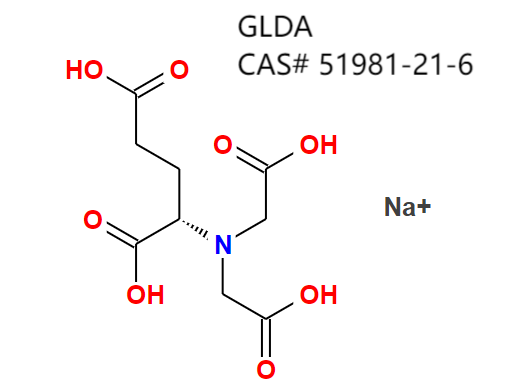CAS No.: 51981-21-6
EC No.: 257-573-7
Chemical formula: C9H9NNa4O8 ;
INCI name: Tetrasodium glutamate diacetate;
Chemical Name:
Glutamic acid N,N-diacetic acid tetrasodium salt;
L-Glutamic acid, N,N-bis(carboxymethyl)-, sodium salt (1:4);
Tetrasodium N,N-bis(carboxylatomethyl)-L-glutamate;
Other Green Chelating Agents:
GLDA è un agente chelante ecologico. Gli agenti chelanti sono anche noti come agenti sequestranti, agenti complessanti, come DTPA, EDTA, HEDP.
GLDA è biodegradabile, privo di fosforo e più rispettoso dell’ambiente.
La principale materia prima di GLDA è MSG (glutammato monosodico), che è di origine naturale.
Caratteristiche:
- Forma complessi idrosolubili con vari ioni metallici in un ampio intervallo di pH, elevata solubilità in soluzioni acide e alcaline.
A differenza di molti acidi aminopolicarbossilici che sono instabili in ambienti acidi, GLDA può esistere stabilmente in ambienti acidi e chelare ioni ferro.
In condizioni alcaline, il GLDA è ampiamente utilizzato come acido aminopolicarbossilico e può chelare bene il calcio e altri ioni metallici. - La resistenza alle alte temperature, l’ambiente ad alta temperatura a lungo termine possono anche mantenere prestazioni stabili.
- Il GLDA ha un effetto di sterilizzazione e di efficacia antisettica, che impedisce alla formulazione o al liquido di processo di scolorirsi e di emanare odori. Contiene un agente chelante aminoacidico, che si combina più facilmente con la parete cellulare, distrugge i batteri e migliora l’effetto dell’uso dei battericidi.
Traditonal Chelating Agents:
Aminopolycarboxylates: EDTA, EDTA-Na, DTPA & DTPA-5Na
Polyphosphonates: HEDP, DTPMP, ATMP
The following is the original English text.
Quello che segue è il testo originale inglese.
GLDA is an environmentally friendly chelating agent (also known as sequestering and complexing agent), biodegradable, phosphorus-free.
GLDA is biodegradable, phosphorus-free, and more environmentally friendly.
The main raw material of GLDA is MSG (monosodium glutamate), which is of natural origin.
GLDA can replace traditional complexing agents such as organophosphorus, EDTA and NTA within a certain range.
Features:
- Form water-soluble complexes with various metal ions in a wide pH range, high solubility in acidic and alkaline solutions.
Unlike many aminopolycarboxylic acids which are unstable in acidic environments, GLDA can exist stably in acidic environments and chelate iron ions.
Under alkaline conditions, GLDA is widely used as an aminopolycarboxylic acid and can well chelate calcium and other metal ions. - High temperature resistance, long-term high temperature environment can also maintain stable performance.
- It has the effect of sterilization and antiseptic efficiency, preventing the formulation or process liquid from discoloration and odor. Contains amino acid chelating agent, easier to combine with the cell wall, destroy the bacteria, improve the effect of the use of bactericides.
Technical Data:
Appearance: colorless to light yellow liquid, aqueous solution;
pH: 11±1 (solution, 25°C);
Density: 1.30~1.50 (solution, 25°C);
Specifications are subject to change without prior notice.
Applications:
GLDA is mainly used as a chelating agent and can be adapted to most traditional chelating agent application scenarios.
Scale inhibitors and descalers, industrial cleaning agents, household detergents, hydrogen peroxide bleach stabilizers (e.g. pulp and paper making, textile bleaching), textiles auxiliaries (metal ion shielding/sequestering agent), metal surface treatment, gas sweetening/desulfurization (iron ion carriers), oilfield chemicals, car cleaning agents, agriculture, etc.
Traditonal Chelating Agents:
Aminopolycarboxylates: EDTA, EDTA-Na, DTPA & DTPA-5Na
Polyphosphonates: HEDP, DTPMP, ATMP
Package and storage:
25kg or 30kg per plastic drum;
125kg, or 250kg per plastic drum;
1250kg per IBC.
Store in a cool and ventilated place indoors, moisture-proof, storage period of 12 months.
Related Water Treatment Products:
| Abbreviation | Product Name | CAS No. | Category |
|---|---|---|---|
| DBNPA | Acetamide,2,2-dibromo-2-cyano- | 10222-01-2 | Biocidal active substances |
| BNP (Bronopol) | 2-Bromo-2-nitro-1,3-propanediol | 52-51-7 | Biocidal active substances |
| PHMB | Poly(hexamethylenebiguanide) hydrochloride | 32289-58-0; 27083-27-8; | Biocidal active substances |
| PHMG | Polyhexamethyleneguanidine hydrochloride; PHMG chloride | 57028-96-3 | Biocidal active substances |
| CMIT/MIT | 3(2H)-Isothiazolone,5-chloro-2-methyl-,mixt. with 2-methyl-3(2H)-isothiazolone | 55965-84-9 | Biocidal active substances |
| Chelating Agents | Complexing Agents, Sequestering Agents: EDTA, DTPA, HEDP, DTPMP, GLDA, MGDA, IDS, ASDA, etc. | Cleaning Agents, Softener, Scale Inhibitor, etc. | |
| HPMA | Hydrolyzed polymaleic anhydride | 26099-09-2 | Polymer, dispersant, scale inhibitor |
| PESA | 2,3-Oxiranedicarboxylic acid, disodium salt, homopolymer | 109578-44-1 | Polymer, dispersant, anti-scaling |
| Sodium Polyaspartate | Polyaspartic Acid Sodium Salt; PASP-Na; | 34345-47-6; 94525-01-6; 181828-06-8 | Polymer, dispersant, scale inhibitor |




